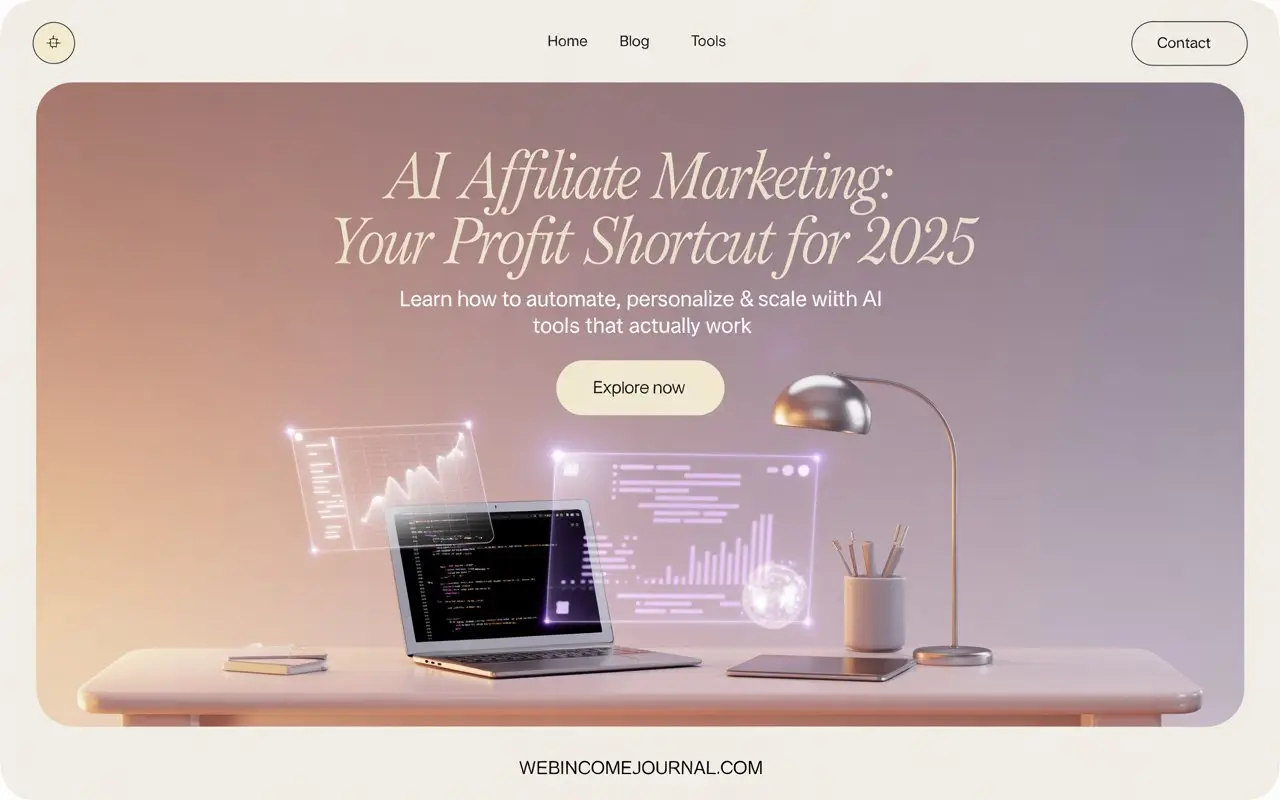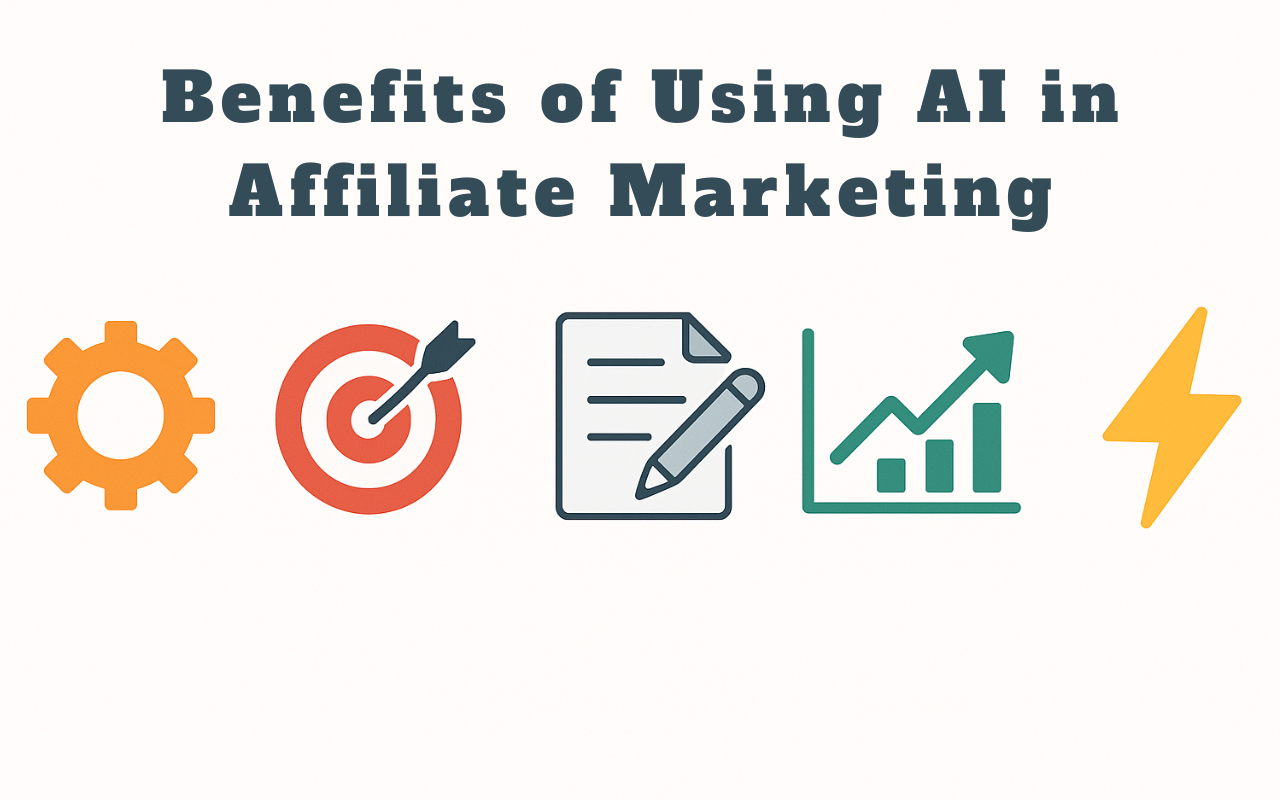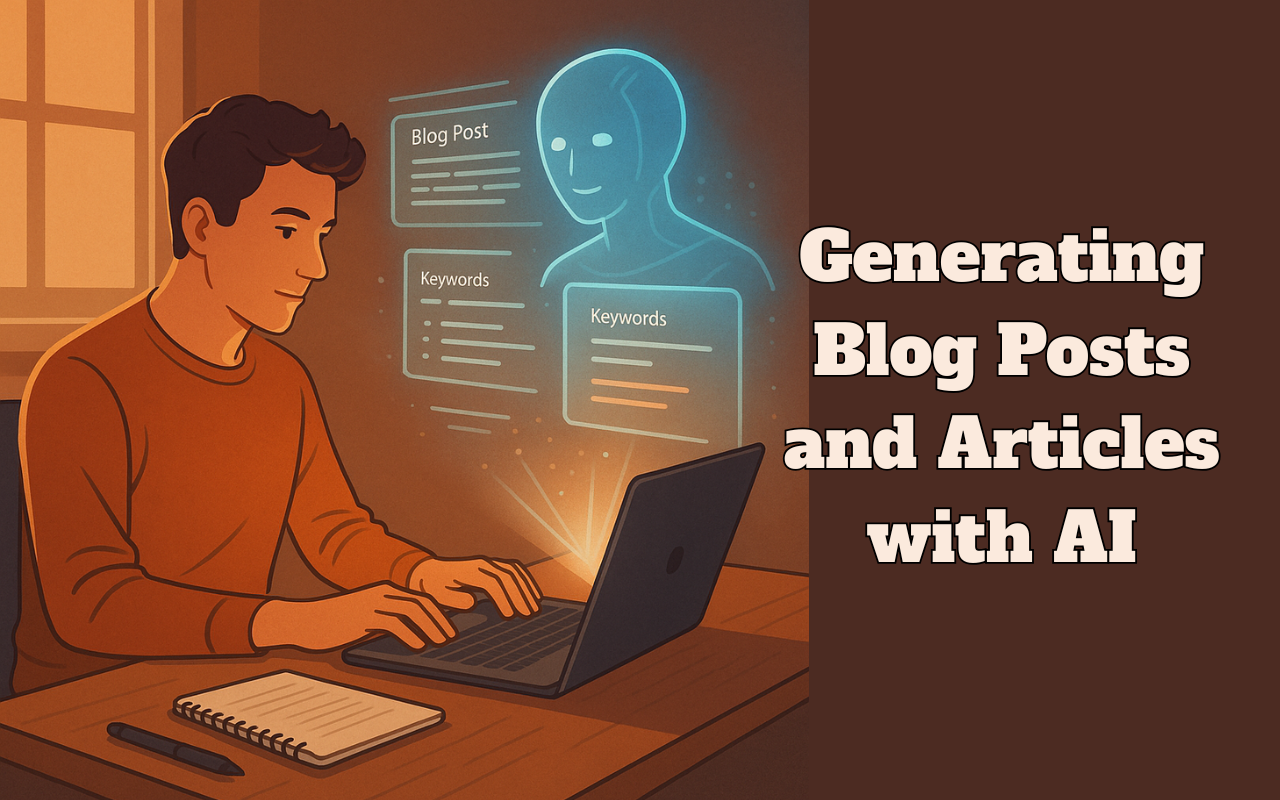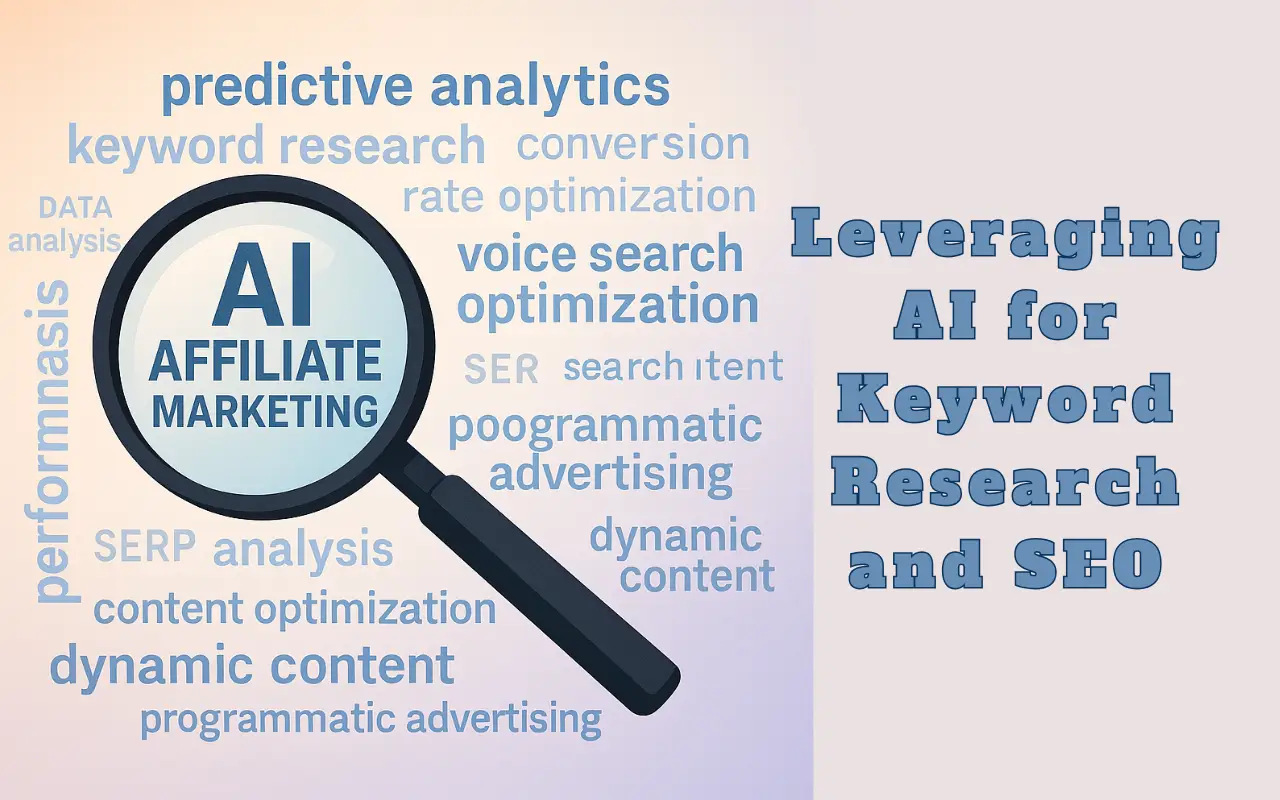
Ever stared at your affiliate dashboard, wondering why those commission numbers aren’t budging?
I have. A few years back, I spent 60 hours a week creating content, optimizing links, and analyzing metrics—all for a measly $400 monthly return.
If you’ve been in this affiliate marketing game for some time now, you’ll agree that traditional affiliate marketing has always felt like pushing a boulder uphill: endless content creation, fickle audience targeting, and brutal competition for eyeballs.
But today, AI has changed everything. In less time and with less effort, you can now research keywords, generate content, and optimize campaigns. And, the numbers speak volumes: 85% of top affiliate marketers now use AI-powered affiliate marketing tools, with early adopters seeing up to 40% higher conversion rates than traditional affiliates.
The affiliate game isn’t just changing—it’s transforming completely. Imagine spending less time on tedious tasks while earning more than ever before.
In this blog post we’ll explore this revolution that is unfolding and how you can leverage this opportunity to automate your way to real affiliate profits in 2025.
Let’s dive in.
What Is AI Affiliate Marketing and How Does It Work?
AI affiliate marketing combines traditional affiliate strategies with artificial intelligence to automate and enhance marketing efforts. Simply put, it uses AI tools to handle tasks that once required hours of human work.
Traditional affiliate marketing relied on manual link placement, content research, and spreadsheet-driven performance tracking. In contrast, AI-powered affiliate marketing tools handle these processes automatically, cutting hours of work down to minutes.
Think of traditional affiliate marketing as manual fishing – you cast lines hoping for bites. AI-powered affiliate marketing acts more like a smart fishing net that knows where the fish swim and adapts to catch more.
Here are some of the key differences between manual and AI affiliate marketing:
| Traditional Affiliate Marketing | AI-Powered Affiliate Marketing |
| Manual content creation | Automated content generation with tools like LongShot |
| Guesswork in audience targeting | Data-driven audience segmentation |
| Static commission structures | Dynamic commission systems through platforms like Tapfiliate |
| Manual performance tracking | Real-time data insights and analytics |
| Fixed campaign schedules | Predictive campaign timing |
How AI is Transforming Affiliate Marketing
AI touches nearly every aspect of affiliate marketing:
- Content Creation: Tools like Murf AI generate product reviews in minutes, not days. GetGenie can create SEO-optimized blog posts that convert at higher rates.
- Audience Targeting: Machine learning audience segmentation identifies exactly who’s most likely to buy. HubSpot’s AI features sort prospects by behavior patterns, increasing conversions by up to 30%.
- Performance Analysis: AI analyzes thousands of data points to spot trends human marketers might miss. SEMrush’s AI tools track competitor strategies and identify content gaps automatically.
- Campaign Optimization: AI tests different approaches simultaneously. As Digital Marketer reports, AI-driven A/B testing improves conversion rates by 25% on average.
Growth Trajectory of AI in Marketing
AI adoption in marketing has been anything but phenomenal in the last few years. According to MarketingAI Institute, 80% of marketers plan to use AI tools by 2025, up from 29% in 2023. And, surveys already show that 64% of marketers are currently using AI in some form, with 21% integrating it deeply into daily workflows.
The technology behind tools like CustomGPT.ai, 10Web, and Creatify grows more sophisticated daily. Dynamic Yield reports that AI-powered personalization delivers 5-15% higher revenue per visitor.
This momentum sets the stage for AI affiliate marketing to become a standard, not an edge, in 2025. For affiliate marketers, this means one thing: those who adopt AI tools will gain significant advantage over those who don’t.
Benefits of Using AI in Affiliate Marketing

The shift to AI affiliate marketing brings five major benefits that directly impact your bottom line. Let’s break them down with real examples.
1. Increased Efficiency & Automation
AI handles the grunt work so you can focus on strategy. Tools like 10Web automate website optimization and maintenance, while Tapfiliate and GetResponse automate link placement, email campaigns, and reporting in minutes. No more copying and pasting hundreds of URLs.
McKinsey reports generative AI could boost marketing productivity by up to 15% of total spend. Example: A marketer using Murf AI slashed video editing time by 70%, freeing hours for strategy, testing new offers, or simply stepping away from your desk.
2. Enhanced Targeting & Personalization
AI excels at hyper-personalization by analyzing customer behavior patterns. CustomGPT.ai users report 40% higher email open rates through AI-generated personalized sequences.
Machine learning audience segmentation identifies micro-niches you might miss. HubSpot’s AI targeting features help affiliates create campaigns that speak directly to specific audience segments, increasing click-through rates by up to 25%.
One fashion affiliate shared: “AI helped me discover that my audience wasn’t just ‘women 25-34’ but specifically ‘eco-conscious professional mothers.’ My conversion rate doubled after refining my messaging.”
3. Improved Content Creation & Optimization
AI content tools speed up writing product reviews and blog posts without sacrificing quality. Tools like Surfer SEO analyzes top-ranking content and guides your writing to match search intent. Grammarly and LongShot help create engaging, error-free content that converts.
Synthesia users create video content 10x faster than traditional methods. One travel affiliate generated 20 destination review videos in a single day – a task that previously took weeks.
With AI content tools, you pump out SEO-friendly, engaging content without staring at a blank page.
4. Data-Driven Decisions
AI analyzes patterns across thousands of data points. Tools like SEMrush track performance in real time, allowing for quick adjustments.
Multi-touch attribution models powered by AI accurately track customer journeys, highlighting every conversion touchpoint. Real-time data insights let you tweak bids or swap creative on the fly. No more gut calls. Your decisions rest on solid numbers.
Affiliates using AI analytics report 20-40% higher ROI by tweaking campaigns in real time.
5. Competitive Advantage
Early adopters of AI-powered affiliate marketing grab market share. They spot profitable niches, like AI affiliate programs for Synthesia or Creatify, before the rest. They test dynamic commission structures that reward long-term loyalty. They leverage AI chatbots to answer questions 24/7.
Tapfiliate data shows affiliates using AI-driven fraud detection and dynamic commission structures outperform competitors by 15-20%.
The opportunity window won’t stay open forever. As AI affiliate marketing becomes standard practice by late 2025, the advantage will shift from having AI to using it most effectively.
Having understood what AI affiliate marketing is and its benefits, let’s now discuss some practical ways you can implement AI in your affiliate marketing strategy.
AI In Affiliate Marketing Content Creation
Creating content used to eat up most affiliate marketers’ time. But today AI tools handle this heavy lifting, allowing you to scale your operation without burning out. Here are some of the ways AI tools can help affiliate marketers with content creation.
Generating Blog Posts and Articles

AI writing tools like LongShot and GetGenie create full blog posts, product reviews, and comparison articles in minutes. These tools analyze top-performing content and generate material that matches search intent.
For example, a few months ago, I tested GetGenie to create a wireless headphone review. After inputting the product name, key specs, and target keywords, the tool generated a 1,500-word review in under 10 minutes. The review included:
- A compelling introduction highlighting user pain points
- Structured sections covering sound quality, battery life, and comfort
- Comparison with competing products
- Pros and cons table
- Natural placement of affiliate links
- A conclusion addressing the ideal buyer
The review needed minimal editing and saved me 3-4 hours of research and writing time. With proper prompting, the AI maintained my voice and writing style throughout.
Crafting Engaging Social Media Content
AI tools can transform product information into platform-specific social posts. CustomGPT.ai can generate a month’s worth of social content in one sitting, complete with hashtag recommendations and posting schedules.
Creatify and Synthesia create short-form videos that convert well on platforms like Instagram and TikTok. One home decor affiliate reported: “I feed Synthesia my product links and key selling points, and it creates 30-second demo videos that I could never produce myself. My click-through rate jumped 35% after adding these videos.”
Producing Effective Email Marketing Copy
Email remains one of the highest-converting channels for affiliates. AI tools like HubSpot’s email generator craft subject lines, preview text, and body copy that tap into reader intent. You provide the campaign goal—say, promoting a new webcam—and the AI suggests three subject lines, an opening hook, and a persuasive close with a clear button link. It even adapts tone: friendly for loyal subscribers, more formal for first-time sign-ups.
When integrated with GetResponse or Tapfiliate you can automate sending based on user behavior. Your sequence goes live while you focus on strategy.
AI-driven subject line testing improves open rates by 15-25% according to HubSpot data. The most effective approach combines AI-generated email frameworks with your personal touches for authenticity.
Optimizing Existing Content with AI
Already have content? AI improves what you’ve created. Surfer SEO and Grammarly analyze your existing articles and suggest improvements for:
- Keyword density and placement
- Sentence structure and readability
- Content gaps compared to top-ranking articles
- Image optimization recommendations
10Web’s AI optimization tools automatically adjust page speed factors that impact both user experience and search rankings.
AI in content creation slashes busywork. It gives you speed, scale, and smarter edits. You shift from writing every word to guiding the narrative—and watch engagement climb. By 2025, 72% of marketers will use AI for content. Why? Speed + precision = profit.
Pro Tip: Always fact-check AI drafts. A human touch ensures accuracy and keeps your voice authentic.
Audience Targeting Using AI
Sending the right offer to the right person at the right time makes all the difference in affiliate marketing. AI transforms audience targeting from guesswork into science.
Analyzing Audience Data
AI tools process thousands of data points to reveal patterns humans might miss. HubSpot’s AI analytics examines user behavior across multiple touchpoints—tracking what content visitors read, which emails they open, and how they interact with your site.
CustomGPT.ai can analyze your existing customer base to identify common traits among your best customers. These insights help you find more people who match your ideal buyer profile.
Segmenting Audiences for Personalized Campaigns
Machine learning audience segmentation divides your traffic into highly specific groups. Instead of broad demographics like “women 25-34,” AI identifies segments like “new mothers interested in organic baby products who shop primarily on mobile devices.”
GetResponse uses AI to create dynamic segments that update automatically based on user behavior. This means your audience groups remain current without manual intervention.
Predictive Analytics for Identifying High-Intent Users
Predictive analytics forecasts which visitors are most likely to convert.
Predictive models analyze signals—time on site, scroll depth, click patterns—and assign a conversion score. Affiliates can use this to prioritize high-score leads, focusing promotions where they’ll yield the biggest ROI. Nvidia’s use of digital twins to simulate customer journeys is a prime example of forecasting outcomes with up to 85% accuracy.
Dynamic Yield data shows that focusing resources on the top 20% of AI-identified high-intent users can generate up to 80% of conversions.
Dynamic Content Delivery Based on User Behavior
Dynamic content feeds change your pages and emails on the fly. Hootsuite reports 80% of social marketers use AI to tailor content per user session—be it a special offer banner or a personalized product feed. That means a first-time visitor sees an intro guide, while a returning shopper gets a VIP discount—automatically.
With AI handling the heavy lifting, your campaigns hit the right inbox, the right feed, and the right offer—every time.
Automating and Optimizing Affiliate Campaigns with AI
To improve campaign performance, affiliates usually spend time and effort at monitoring and tweaking ads and creative. But manual doing this limits how many affiliate offers you can run effectively. The good news is that AI automation tools now handle the heavy lifting so you can scale your efforts and improve results. Here’s how:
AI-Powered A/B Testing
A/B testing remains a core tactic, but AI takes it further. While traditional A/B testing takes weeks and tests only one variable at a time AI-powered tools, like SEMrush test 10 ad variations at once—headlines, images, CTAs – and identify winning combinations faster.
Again, traditional A/B tests run for fixed periods but AI algorithms redistribute traffic in real time, pulling back on losers while scaling up winning variants—even retesting past winners for new trends. HubSpot’s AI testing tools automatically allocate more traffic to better-performing variations in real-time, maximizing conversions during the testing process itself.
This constant optimization squeezes out every drop of performance, turning what was once a slow experiment into an ongoing conversion engine.
Real-time Performance Monitoring and Adjustments
Gone are the days of daily checks and manual tweaks. Today AI tools can monitor your campaigns 24/7 and make adjustments based on performance data. AI tools like GetResponse’s AI campaign optimizer tracks metrics like open rates, click-throughs, and conversions, then automatically adjusts send times, subject lines, and content to improve results. In the same vein, SEMrush’s AI monitoring tools can detect when competitors change their strategies and alert you to potential threats or opportunities.
These systems watch performance continuously and rebalance budgets, so you never miss an opportunity to optimize.
Smart Bidding Strategies
Beyond basic CPC tweaks, AI bidding offers goal-based options. Target CPA, Target ROAS, and Maximize Conversion Value strategies learn from historical and real-time data to bid where it counts. Tools like Google Ads Smart Bidding set bids at auction time, weighing dozens of contextual signals—device, location, time, and more—to hit your target goals. In one test, OLX saw an 89% jump in conversions at 32% lower cost per action compared to manual bidding.
Another example of AI smart bidding is CustomGPT.ai’s affiliate dashboard which includes AI bid management that automatically adjusts PPC bids based on real-time conversion data.
By automating bid decisions, you capture high-value clicks and avoid wasted spend—without lifting a finger.
Automated Reporting and Analytics
Manually pulling performance spreadsheets is history. Platforms like Semrush let you schedule fully automated PDF or dashboard reports that update with fresh data and email themselves to stakeholders. The Semrush AI Automated Data Connector even exports campaign metrics directly into Google Sheets on a set schedule, so your reports reflect live performance without any effort.
AI reporting tools turn complex data into actionable insights. Rather than drowning in spreadsheets, you get clear recommendations.
AI Chatbots for Enhanced Affiliate Engagement
AI chatbots handle lead qualification, FAQs, and even product recommendations—so no question goes unanswered. The chatbot market is projected to reach $1.25 billion by 2025, growing at a 24.3% CAGR. On affiliate sites, chatbots guide visitors to relevant offers, answer objections, and nudge them toward purchase links, boosting conversions and affiliate commissions.
Tools like Creatify’s affiliate chatbots can explain product features, provide pricing information, and offer personalized recommendations based on visitor behavior. Case studies show that pairing real-time optimization with conversational AI can lift engagement and drive sustained revenue growth.
Leveraging AI for Keyword Research and SEO

Keywords are the foundation of affiliate success. While there has been a number of keyword research tools for finding the right keywords, these traditional keyword tools used to take a lot of man hours. But not anymore. Today, AI tools have transformed this process from guesswork into a data-driven strategy that delivers results.
AI-driven tools can scan millions of search terms to pinpoint high-potential, low-competition keywords in seconds. SEObotAI, for example, analyzes search volume, keyword difficulty, and competitor gaps to recommend phrases you can rank for faster.
Similarly, LongShot.ai’s Co-Pilot feature suggests long-tail keywords tied to your topic and shows estimated traffic gains and 10Web’s AI SEO tool also pulls related keywords automatically, giving you clusters of terms to target in one click.
Below are some of the ways that AI can be used for keyword research and SEO:
Identifying High-Potential, Low-Competition Keywords
AI-powered SEO tools can analyze billions of search queries to find keyword opportunities you’d likely miss manually. Tools like Surfer SEO uses machine learning to identify keywords with high traffic potential but low competition – the sweet spot for affiliate marketers. SEMrush’s AI features can analyze your niche and suggest keyword clusters based on what real users search for. This helps you build content that matches actual search behavior rather than assumptions.
These AI systems examine:
- Search volume trends over time
- Competition difficulty scores
- Click-through rates for specific terms
- User engagement metrics
Analyzing Search Intent with AI
Understanding why someone searches is crucial. AI doesn’t just find keywords – it categorizes them by intent.
For example, GetGenie can distinguish between:
- Informational queries (“how does AI affiliate marketing work”)
- Commercial queries (“best AI marketing tools”)
- Transactional queries (“buy CustomGPT.ai subscription”)
This intent analysis helps you create content that matches what users actually want. According to a 2024 study by Backlinko, content aligned with search intent converts 87% better than keyword-stuffed articles that miss the mark.
Optimizing Content for SEO with AI Recommendations
AI doesn’t stop at finding keywords – it helps you use them effectively. Tools like Surfer SEO analyze top-ranking pages and provide specific recommendations:
- Optimal keyword density
- Suggested headings and subheadings
- Word count targets
- Content structure improvements
LongShot AI can generate SEO-friendly content outlines based on what’s already ranking well. By following these AI-generated guidelines, you’re building content with a proven formula for success.
Competitor Keyword Analysis
Why guess what works when AI can show you? Tools like SEMrush use machine learning to reveal exactly which keywords drive traffic to your competitors.
HubSpot’s AI analytics platform can track competitor content performance in real-time, showing you which affiliate product reviews are gaining traction so you can adjust your strategy accordingly.
These AI-powered insights eliminate the mystery from SEO, turning keyword research from an art into a precise science that consistently delivers higher rankings and more affiliate commissions.
AI-Driven Competitor Analysis for Affiliate Marketers
Succeeding as an affiliate marketer demands you keeping a close eye on competition and then using their strategies as a springboard for improvement. AI tools now make this process faster and more insightful than ever before. Here’s how:
Identifying Top Competitors and Their Strategies
AI-powered competitor analysis tools can scan entire markets in minutes. SEMrush and similar platforms use machine learning to identify:
- Who truly competes with you for the same audience
- Which content formats drive their success
- What affiliate products generate the most revenue
- How they structure their promotional campaigns
AI tools from companies like HubSpot can analyze your competitors’ backlink profiles, showing exactly where their traffic comes from. This reveals potential partnership opportunities you might have missed.
Uncovering Content Gaps and Opportunities
AI excels at spotting patterns humans miss. Content gap analysis tools identify topics your competitors cover that you don’t—and vice versa.
CustomGPT.ai’s competitive analysis feature can:
- Detect trending topics in your niche that competitors haven’t covered yet
- Identify questions your audience asks that nobody answers well
- Find product comparisons with incomplete or outdated information
A 2024 study by Content Marketing Institute found that affiliates who used AI to identify content gaps increased their conversion rates by 43% compared to those using manual research methods.
10Web’s AI tools can analyze competitors’ content structure, showing you which headings, word counts, and content types perform best for specific affiliate promotions.
Monitoring Competitor Performance and Adaptations
Markets change constantly. What works today might fail tomorrow. AI monitoring tools provide real-time insights into competitor strategies.
Tapfiliate’s AI monitoring features track:
- Changes to competitor promotional strategies
- Shifts in commission structures
- New product launches and promotional campaigns
- Content updates and republishing patterns
These AI-driven insights help you stay agile in the competitive affiliate marketing landscape, turning potential threats into opportunities for growth.
Ethical Considerations in AI Affiliate Marketing
The power of AI in affiliate marketing brings important ethical responsibilities. Balancing automation with integrity keeps your audience’s trust and protects your business long-term.
Ensuring Accuracy and Fact-Checking AI-Generated Content
AI tools create content quickly, but they can make mistakes. According to a 2024 survey by the Content Marketing Institute, 73% of consumers said they lost trust in brands after encountering factual errors in AI-generated product reviews.
Human oversight remains essential:
- Review all AI-generated product claims before publishing
- Verify specifications, pricing, and availability
- Test products personally when possible
- Add your genuine experiences to AI-drafted content
Addressing Potential Bias in AI Algorithms
AI systems learn from existing data, which can contain biases. This affects which products get recommended and how they’re described.
Tools like Grammarly now include bias detection features that flag potentially problematic language or unbalanced comparisons in your affiliate content.
Mitigate these issues by:
- Using diverse training data for your AI tools
- Checking recommendations across demographic groups
- Being mindful of which products get featured prominently
- Questioning why certain products are ranked higher than others
Data Privacy and Security
AI affiliate marketing uses customer data to personalize recommendations. With this comes serious privacy obligations. Tapfiliate’s security features include encryption and anonymization tools that help affiliates comply with regulations like GDPR and CCPA.
Best practices include:
- Clearly explaining how you use customer data
- Minimizing data collection to what’s actually needed
- Implementing strong security measures
- Allowing users to opt out of personalization
Maintaining Authenticity and Transparency
AI enhances your capabilities but shouldn’t replace your authentic voice. According to a HubSpot study, 65% of consumers can detect purely AI-generated content, and 82% prefer content with genuine human input.
Balance automation with authenticity by:
- Disclosing when AI tools assist with content creation
- Adding personal stories and genuine product experiences
- Being honest about affiliate relationships
- Using AI for research and drafting, but adding your unique perspective
Conclusion
In this article you’ve learned that AI affiliate marketing AI isn’t the future—it’s now. From automating content to hyper-targeting audiences, AI has shifted affiliate tactics from manual tasks to automated, data-driven workflows, transforming guesswork into profit.
Imagine slashing hours on keyword research with Surfer SEO or boosting ROI by 40% with predictive analytics. The tools are here, the results proven.
The question isn’t if you’ll adopt AI, but when. So, why wait?
Pick a tool today. Take action. Real profits in 2025 are within reach.
Frequently Asked Questions about AI Affiliate Marketing
-
Can I use AI in affiliate marketing?
Yes. You can use AI tools to automate content creation, find keywords, target audiences, track performance, and improve SEO. This helps save time and increase your affiliate revenue.
-
Can you make $100 a day with affiliate marketing?
Yes, it’s possible. Many affiliates reach $100 a day by promoting high-converting products, building traffic, and optimizing their content. AI tools can help speed up the process.
-
How much can a beginner make in affiliate marketing?
Beginners often make between $0 and $500 per month in the first few months. Results depend on your niche, content quality, traffic, and how well you use tools and strategy.
-
How to do affiliate marketing without showing your face?
You can write blog posts, build email lists, run ads, or create voice-only videos. Use tools like Murf AI or Synthesia to generate content without showing yourself on camera.
-
Can affiliate marketing be automated?
Yes. You can automate emails, content scheduling, keyword tracking, and performance reports using AI-powered tools like GetResponse, Tapfiliate, and HubSpot.
-
How to do AI affiliate marketing?
Start by choosing AI tools for content writing, SEO, and campaign tracking. Use platforms like CustomGPT.ai, Surfer SEO, and Dynamic Yield to automate and personalize your affiliate strategy.







“Loved this post! You explained everything so clearly and made it easy to follow. Thanks for sharing your insights!”
Great Information Provided Thanks For The Information !